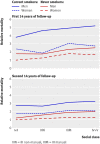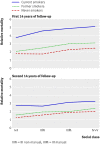Effect of tobacco smoking on survival of men and women by social position: a 28 year cohort study
- PMID: 19224884
- PMCID: PMC2645845
- DOI: 10.1136/bmj.b480
Effect of tobacco smoking on survival of men and women by social position: a 28 year cohort study
Abstract
Objective: To assess the impact of tobacco smoking on the survival of men and women in different social positions.
Design: A cohort observational study.
Setting: Renfrew and Paisley, two towns in west central Scotland.
Participants: 8353 women and 7049 men aged 45-64 years recruited in 1972-6 (almost 80% of the population in this age group). The cohort was divided into 24 groups by sex (male, female), smoking status (current, former, or never smokers), and social class (classes I + II, III non-manual, III manual, and IV + V) or deprivation category of place of residence.
Main outcome measure: Relative mortality (adjusted for age and other risk factors) in the different groups; Kaplan-Meier survival curves and survival rates at 28 years.
Results: Of those with complete data, 4387/7988 women and 4891/6967 men died over the 28 years. Compared with women in social classes I + II who had never smoked (the group with lowest mortality), the adjusted relative mortality of smoking groups ranged from 1.7 (95% confidence interval 1.3 to 2.3) to 4.2 (3.3 to 5.5). Former smokers' mortalities were closer to those of never smokers than those of smokers. By social class (highest first), age adjusted survival rates after 28 years were 65%, 57%, 53%, and 56% for female never smokers; 41%, 42%, 33%, and 35% for female current smokers; 53%, 47%, 38%, and 36% for male never smokers; and 24%, 24%, 19%, and 18% for male current smokers. Analysis by deprivation category gave similar results.
Conclusions: Among both women and men, never smokers had much better survival rates than smokers in all social positions. Smoking itself was a greater source of health inequality than social position and nullified women's survival advantage over men. This suggests the scope for reducing health inequalities related to social position in this and similar populations is limited unless many smokers in lower social positions stop smoking.
Conflict of interest statement
Competing interests: None declared.
Figures



References
-
- Commission on Social Inequalities in Health. Achieving health equity: from root causes to fair outcomes. Geneva: World Health Organization, 2007. - PubMed
-
- Jarvis M, Wardle J. Social patterning of individual health behaviours: the case of cigarette smoking. In: Marmot M, Wilkinson R, eds. Social determinants of health. Oxford: Oxford University Press, 1999.
-
- Gordon D, Shaw M, Dorling D, Davey Smith G, eds. Inequalities in health. Bristol: Policy Press, 1999.
-
- Hawthorne VM, Watt GCM, Hart CL, Hole DJ, Smith GD, Gillis CR. Cardiorespiratory disease in men and women in urban Scotland: baseline characteristics of the Renfrew/Paisley (Midspan) study population. Scot Med J 1995;40:102-7. - PubMed
Publication types
MeSH terms
LinkOut - more resources
Full Text Sources
Medical
